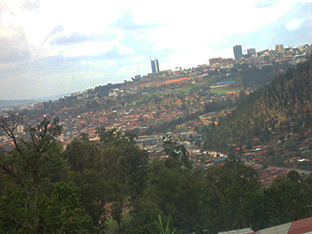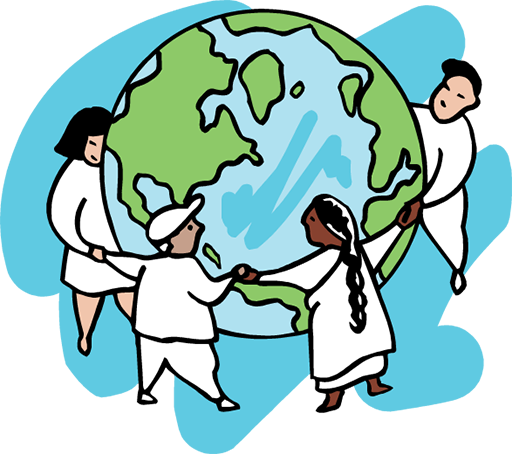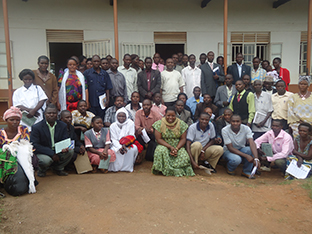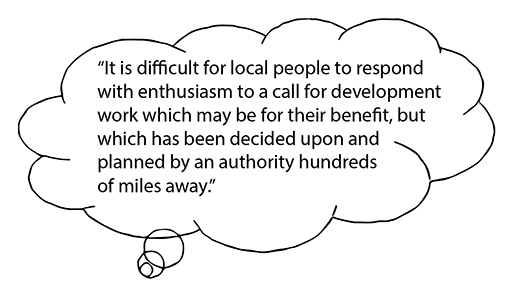3.3 The concept of community mobilisation
A community is usually defined as a group of people who live within a geographically defined area and who share a common language, culture or values (Figure 3.1). In short, it is an area or a village with families who are dependent on one another in their day-to-day lives and activities, and who all benefit from that inter-dependency. However, sometimes a group of people who do not live together but have something in common like a special interest or job role are also referred to as a community.

To mobilise is to get something or someone ‘on the move’. It follows then that community mobilisation is about organising and motivating the community to move them towards achieving a certain goal. Community mobilisation is defined as a process through which individuals, groups and families, as well as organisations, plan, carry out and evaluate activities on a participatory basis to achieve an agreed goal. This might be on their own initiative, or for a goal suggested or initiated by others – like a health worker.
What do you observe from Figure 3.1? Can one person manage moving this big item they are struggling with? How do you get people to come together to moving this ‘BIG’ item?

This illustrates the idea of community mobilisation. Just as the community might need to come together to achieve any big task, so this can be the case with children’s rights and health issues. In an earlier session you looked at advocacy and explored how sometimes bigger (‘louder’) strategies are needed when supporting individuals. Sometimes to achieve a big change we need to find ways of motivating a whole community to take action.
Through community involvement, local communities and professional people can identify health problems, pool their knowledge and experience, and develop ways and means of solving them (Figure 3.2). Your role is to help the community organise itself so that learning will take place and action follows. The health worker cannot achieve wider health goals without involving the community. For example, a health worker might be facing regular cases of children with illnesses arising from drinking contaminated water. While you can treat each child, the only long-term answer is to address the source of the problem and try and improve the water supply. However, you cannot achieve this goal on your own. Only by mobilising the community might you be able to build the momentum necessary to take action to improve the water supply. This can only be achieved by building on the community’s knowledge and beliefs, not by anyone dictating to them what they should do (Figure 3.3).


Community mobilisation is …
Working with the whole community – women and men, young people, and children
Seeking to encourage individuals and the community to embark on a process of change
Using strategies over time to build a critical mass of individuals supportive of child rights
Supporting people to face the fact that issues such as violence against children and rights issues are not something ‘out there’: it is something we all grapple with in our communities
Inspiring and creating activism among a cross-section of community members.
Community mobilisation is not …
Only raising awareness
Working with one sector, group or sex
A series of one-off activities
Pointing fingers, blaming or assigning fault
Top-down programme implementation by an NGO to a community
Completed within short time frames.
Activity 3.1 Mobilising for birth registration
Look at UN Convention and African Charter in the resources, read what it says about birth registration and then answer the following questions:
- Which article and section explains the right to birth registration?
- Why is achieving higher levels of birth registration considered so important?
- How could community mobilisation help achieve this?
Compare your answers to those at the end of the study session.
Activity 3.2: Mobilising in your community
Now think of two other issues related to children’s rights in health care in the community where you work.
- Why are they important?
- Why would it be beneficial to involve the wider community in each case?
Discussion
- There is a whole range of issues related to health and to children’s rights where mobilising the community could play an important role. You might, for example, want to improve access to confidential reproductive health services for young people, address the prevalence of early marriage, tackle the harmful effects of child labour, improve the access to health care for children with disabilities. Discuss your answers with a colleague and see if they agree or have different suggestions about what issues could be tackled in your community.
- Communities are a primary source of solutions and sustainability for the promotion and respect of children's rights. By making efforts to involve all stakeholders, including children, in communities to promote children rights, you can achieve the following benefits:
- Community involvement helps bring together contributions of a variety of resources, including financial and material that are supportive of children's rights.
- Community involvement will lead to a positive influence on the community's perception of children rights.
- It creates ownership and sustainability for children's rights efforts through shared decision making and communication.
- It helps raise children’s concerns to the centre of the community agenda.
- Community involvement helps bring together different groups of people and organisations to collectively advocate for specific policies, attitudes and practices in support of the health and well-being of children.
- It can influence policies and attitudes more effectively than can be achieved through isolated efforts by individual organisations and people in a given community.
- It generates empowerment in the community that fosters individual and collective responses for children's rights.
- Community involvement helps in building sustainable social support systems that are beneficial to disadvantaged families and children.
3.2 Learning outcomes
